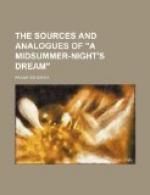Leaving classical lands and times, we find in the tenth century, amongst the Eddic Lays of northern Europe, the following passage:—
“It was in the olden days ... when Helgi the stout of heart was born of Borghild, in Braeholt. Night lay over the house when the Fates came to forecast the hero’s life. They said that he should be called the most famous of kings and the best among princes. With power they twisted the strands of fate for Borghild’s son in Braeholt...."[50]
Here the “Fates” are the “Norns” of the northern mythology. We find them practising the same functions again in twelfth century Saxo Grammaticus,[51] who calls them “three maidens”; their caprices are shown when two of them bestow good temper and beauty on Fridleif’s son Olaf, and the third mars their gifts by endowing the boy with niggardliness.
In commenting upon both the Eddic Lay and the Danish Historian, the editors remark that this point of the story—the bestowal of gifts at birth—survives in the chanson de geste of Ogier the Dane,[52] whose relations with the fairy-world may be narrated shortly as follows.[53]
At the birth of Ogier the Dane, five fairies promised him strength, bravery, success, beauty, and love; after them came Morgan le Fay, whose gift was that, after a glorious career, Ogier should come to live with her at her castle of Avalon. When the hero was over a hundred years of age, Morgan caused him to be wrecked near Avalon. In his wanderings he comes to an orchard, where he eats an apple. A beautiful lady approaches whom he mistakes for the Virgin; but she tells him she is Morgan le Fay. She puts a ring on his finger and he becomes young; she puts a crown on his head, and he forgets the past. For two hundred years he lives in unearthly delights, and the years seem to him to be but twenty. He then returns to earth to champion Christendom; but after triumphing over his foes he returns to Avalon.[54]
The tale of Ogier was long popular in Denmark—of which country he is the national hero—and also in France; and the notion of supernatural gifts at birth has obtained a very wide vogue. But Ogier’s story also exhibits another very popular piece of superstition—that of a journey to or a sojourn in the supernatural world.[55] Our English parallel to Ogier, as Professor Child points out,[56] is Thomas of Erceldoune.
This leads us to the consideration of three English metrical Romances, which in all probability are derived from French sources, containing accounts of the visits to fairy-land made by Thomas of Erceldoune, Launfal, and Orfeo. The first and last of these are also known in the form of ballads; whether these ballads derive directly from the romances, or may be supposed to have existed side by side with them in the fifteenth century, is a question which must not delay us here. The romances and the ballads may all have been known to Shakespeare in book-form or in tradition.




